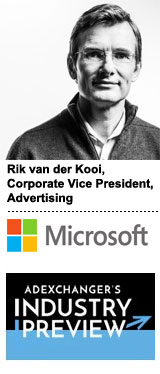
Microsoft is betting on “screenless advertising.”
As voice-activated personal assistants like Cortana improve, consumers will use them not only for information, but to buy things. And once voice and chat become commonplace ways to purchase, so advertising will happen through this new medium of communication.
Consumer needs, expectations and technology will finally come together to enable “conversational commerce,” said Rik van der Kooi, corporate VP of Microsoft advertising sales and marketing. For Microsoft, this means an era of screenless advertising.
Besides focusing on the future of digital marketing, van der Kooi manages a business that spans search marketing and display advertising. Microsoft controls search marketing end-to-end. For display advertising, it handles everything up to the advertising sales process, when it hands off to AOL for direct sales and AppNexus for programmatic monetization.
Van der Kooi talked with AdExchanger.
Why does Microsoft see “screenless advertising” as its future?
RIK VAN DER KOOI: New devices, processing power available through cloud computing and machine learning improvements, and consumer needs [are coming together]. You see an evolution of chat-based environments, and the notion of wanting access to all of my information and the world’s information while I’m on the go.
For the last decade, the focus in the digital marketing industry has been on making advertising more visually appealing, whether that’s through video ads or richer display ad formats or native ad formats. While that effort and quest isn’t going to go away, screenless advertising will be an important complement to this, as people and consumers start speaking to their personal assistants in a variety of physical environments, but mostly while they are on the go.
What does this mean for marketers?
Marketers need to think about screenless advertising and playing in a world where they can create closer connections because customers are actually speaking to [the company]. Of course, you may be talking into the smartphone, but the advertising or marketing experience doesn’t rely on the screen.
Search really is a central capability for this new marketing opportunity. There will be more data for the marketer to understand their consumer and deliver more relevant messages and offers.
When will we see these predictions come to fruition?
Marketers are taking advantage of these capabilities right now through the Alexa, Google Home or [home and car audio equipment manufacturer] Harman Kardon, which has our Cortana capabilities embedded in them.
We make our capabilities available through the bot framework. There are multiple environments emerging, and marketers want to play in them but don’t want to repeat the effort four or five times.
Our bot framework enables them to create the bots, and for the bot to live on whatever device or platform the user is using, and interpret the signals from the bots in these very disparate environments. We want to understand the utterances and interactions, and be able to respond to them and run analytics against them.
Let’s shift to Microsoft’s current advertising business. Microsoft acquired LinkedIn, which sells native ads on its own and uses AppNexus for programmatic. To what extent has the LinkedIn advertising opportunity changed?
Our intent is to have LinkedIn stand alone and to grow the business. With [Bing, LinkedIn,] MSN, Skype, Xbox and Outlook.com, we want to be very thoughtful about where it makes sense to combine.
Where would it make sense to combine LinkedIn with other Microsoft properties?
We both have ID-based services, and there is an obvious benefit to the user of being able to connect [LinkedIn with other Microsoft services] more effectively. But those are at the early stages of development discussion.
How has outsourcing display sales worked out so far?
We feel very good about the partnerships we have with AOL/Verizon and AppNexus. The three companies work together very well, and we feel very good about how both of these partners are continuing to grow our business, and how they have our goals and interests in mind.
Our emphasis on growing our search sales force has been very well received by the market. Relationships with agencies and marketers have grown significantly, which creates better balance in the ecosystem. And the performance of Bing Ads tends to compare very well with alternatives in the market. The degree to which the sales force helps to connect marketers back into the platform has been beneficial to the marketing community and us.
This interview has been condensed and edited.
This post was syndicated from Ad Exchanger.
